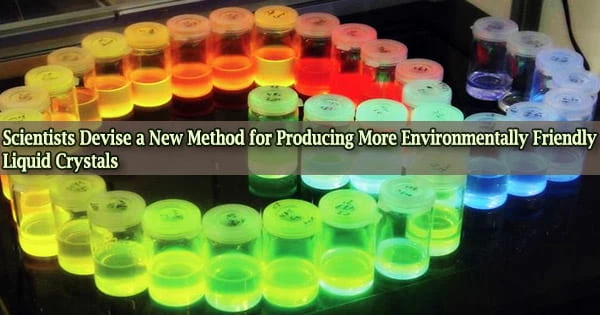Liquid crystals could be created more effectively and environmentally friendly in the near future. Researchers at Martin Luther University Halle-Wittenberg (MLU), Bangalore University in India, and Cairo University in Egypt have created a novel technique.
A liquid crystal is a state of matter that exists in the transition between liquid and solid (a “mesophase”). They have the molecular alignment features of a solid crystal yet change shape like a fluid. As the team explains in the Journal of Molecular Liquids, it is speedier, more energy-efficient, and offers a high yield when compared to traditional approaches.
The majority of smartphones, tablets, and computer screens use liquid crystals. The most frequent varieties utilized in electrical displays are nematic, cholesteric, and smectic, which are made up of organic, rod-shaped molecules that align in parallel.
Liquid crystal manufacturing is a multi-step process with multiple intermediary phases. Molecules, usually fairly elongated organic molecules with dissimilar local structural areas that can interact in an orderly way with their neighbors, are the structural units capable of creating liquid crystals.
However, manufacturers would have to rebuild parts of their manufacturing. This has not happened in the past with other promising materials.
These attraction forces can lead to a degree of self-organization over a given temperature range, in which crystal-like order survives in some directions while it is lost in others.
“Often it requires various solvents and expensive catalysts,” says Dr. Mohamed Alaasar, a chemist at MLU.
The team, which included members from Germany, India, and Egypt, was looking for a means to streamline the process while also reducing its environmental impact.
The concept: rather than having chemical reactions occur one after another, certain processes could be combined in a multicomponent reaction, in which multiple substances react immediately with one another.
The researchers devised a method for making liquid crystals that does not use toxic solvents and relies on less expensive catalysts.
“We were able to achieve a yield of about 90 percent. This means that most of the chemicals are used in the process and relatively few residues are produced,” explains Alaasar.
This saves energy and, as a result, money. The newly formed liquid crystals are in a nematic phase, which is a specific arrangement of molecules employed in most liquid crystal displays or LCDs, at room temperature.
The researchers have only experimented with their novel approach in the lab thus far. Alaasar, on the other hand, is certain that it could be done on a large scale. Although a wide range of molecules can form liquid crystals, the following basic scheme can be used to depict the simplest and most prevalent forms:
The two benzene rings give the molecule a degree of planarity, which enhances interactions between molecules. When the linkage group has a double bond, such as -(HC=N)-, the planarity is improved, keeping the rings in the same plane.
The terminal group is frequently (but not always) polar, resulting in intermolecular interactions along the long axis.
The side chain is commonly a hydrocarbon chain that serves to elongate the molecule.
“However, manufacturers would have to rebuild parts of their manufacturing. This has not happened in the past with other promising materials,” says the scientist.
Consumers, on the other hand, have begun to value sustainability and more ecologically friendly items in recent years. That could be another reason in favor of the new strategy.





